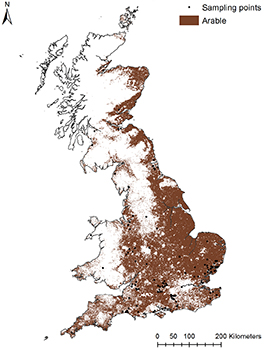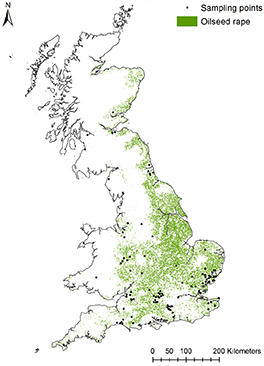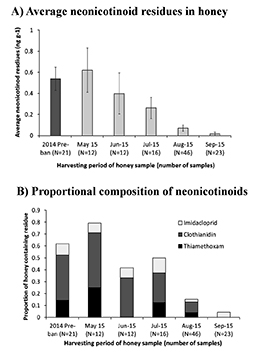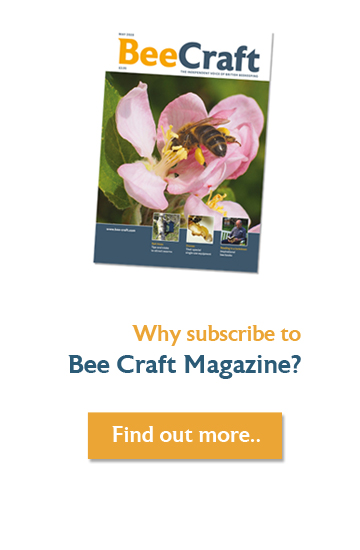Traces of neonicotinoid pesticides have been found in honey one year after the start of the European Union ban on their use on flowering crops. In a beekeeper-citizen science project, led by the Centre for Hydrology and Ecology (CEH), one in five of the post-moratorium honey samples were found to contain traces of the pesticides.
Although the minute traces pose no risk to humans, there is concern that they may have long-term, sublethal effects on honey bees, other pollinators and non-target insects. UK beekeepers are now being encouraged to take part in a national scheme to monitor pesticide residues in honey over a long-term study period.
The CEH honey study involved 130 honey samples supplied mostly by amateur beekeepers across the country in 2014 and 2015 (see Fig 1 overleaf). About 50% of the 2014, pre-ban sample were found to contain neonicotinoids, but as many as 20% of the post-ban samples also contained the pesticides.
The concentrations were very far below those that might be injurious to human health – never more than two parts per billion, whereas the permitted level for human consumption is around 500 parts per billion. The toxicity of the chemicals to invertebrates is very much higher than for humans and mammals and is therefore the focus of concern.
Persistence Pathways
 Lead author of the study Dr Ben Woodcock told Bee Craft, ‘The purported half-life of neonicotinoids in soils suggests that they are a relatively short-lived compound, so the general expectation was that neonicotinoids would disappear with the start of the ban. Our key goals were to establish the environmental persistence of these chemicals and, if they do persist, the likely mechanisms of exposure. While the frequency of neonicotinoid-contaminated samples did fall once the EU ban was in place, our data suggest that these pesticides remain prevalent in the farming environment.’
Lead author of the study Dr Ben Woodcock told Bee Craft, ‘The purported half-life of neonicotinoids in soils suggests that they are a relatively short-lived compound, so the general expectation was that neonicotinoids would disappear with the start of the ban. Our key goals were to establish the environmental persistence of these chemicals and, if they do persist, the likely mechanisms of exposure. While the frequency of neonicotinoid-contaminated samples did fall once the EU ban was in place, our data suggest that these pesticides remain prevalent in the farming environment.’
The study indicated that presence of neonicotinoids in honey correlated with the presence of oilseed rape (OSR), the main pollinated crop on which the pesticides are used in Britain. This result suggests, but doesn’t prove, that oilseed rape grown on land that has residues of neonicotinoids from previous agricultural practice may be the way exposure continues.
However, the moratorium banned neonicotinoids only on flowering crops – with their use continuing on winter-sown cereals, especially wheat. Residues from that usage may mean that neonicotinoids continue to be found in soils after the ban. That was not the focus of the CEH study, but future work may enable investigation of this in the research design.
Spatially, the variation in the persistence of the neonicotinoids is still not understood. They may persist in some areas longer than in others because of factors like the microclimates of shady field corners. ‘It seems that under certain circumstances the pesticides may have higher levels of persistence than was previously thought,’ explains Dr Woodcock. ‘Under ideal conditions they may dissipate relatively quickly.’

Seasonal Decline
 Concentrations of neonicotinoids did decline from May to September following the moratorium (see Fig 2). This could have resulted from OSR and other flowers being less abundant for foraging later in the season rather than a decline of the pesticides in the environment, but no firm conclusions could be drawn from this study. However, the researchers tended to the view that it was the mass-flowering plants (in this case OSR), rather than wild flowers, that were the key transmission route, although the latter cannot be ruled out. Agricultural systems are complex, so further work is required to answer this question.
Concentrations of neonicotinoids did decline from May to September following the moratorium (see Fig 2). This could have resulted from OSR and other flowers being less abundant for foraging later in the season rather than a decline of the pesticides in the environment, but no firm conclusions could be drawn from this study. However, the researchers tended to the view that it was the mass-flowering plants (in this case OSR), rather than wild flowers, that were the key transmission route, although the latter cannot be ruled out. Agricultural systems are complex, so further work is required to answer this question.
As experienced beekeepers will be aware, honey bees will readily transport honey around the hive. Might the 2015 contamination simply be remnants from 2014? That isn’t very likely, says Woodcock, because a significant dilution effect would be likely to show up. The concentration levels found in positive 2015 samples were similar to the levels found in 2014. Longer-term surveys should give even better insights into persistence issues.
Long-term Surveys
In the future, new pesticides will inevitably come on to the market and Woodcock hopes that a planned long-term survey will give early warnings of potential problems. If such early warnings had been available for neonicotinoids, action may have been possible to mitigate the effects rather than the imposition of a complete ban, he says.
Even as an ecologist, Woodcock accepts that modern farming cannot operate without pesticides. A key goal is to help move towards the use of pesticides in the most efficient manner possible, reducing environmental risk while maintaining crop protection and farmer livelihoods. Part of this will involve greater use of natural pest control, such as that provided by predatory beetles and parasitic wasps.
National Honey Monitoring
The focus of the planned National Honey Monitoring Scheme (www.ceh.ac.uk/our-science/projects/national-honey-monitoring-scheme) will not be restricted to neonicotinoids. It will investigate the effects of a variety of pesticides and attempt to link these to productivity and disease of honey bee colonies. DNA analysis of honey will also be able to show which crops and wild flowers the bees are foraging to give fine-grained detail of what is happening in the field.
The project can only succeed with the participation of beekeepers over several years and CEH is asking willing beekeepers to register their interest.
Woodcock says CEH has been very encouraged by the positive beekeeper involvement in the first survey and hopes that this will continue with the new project, indicating that there should be lots of feedback for beekeepers about their colonies.
Ultimately, information from the study is designed to help scientists, apiarists, landowners and policy-makers make much-needed evidence-based management and policy decisions.
The National Honey Monitoring Scheme forms part of the £12 million ASSIST (Achieving Sustainable Agricultural Systems) project (www.ceh.ac.uk/our-science/projects/ASSIST), funded by the Biotechnology and Biological Sciences Research Council and by the Natural Environment Research Council. The project is being led by CEH with multidisciplinary expertise contributed by Rothamsted Research, the British Geological Survey, the farming industry and others.
Through the ASSIST project, CEH and its partners are looking to achieve profitable and high-production farming systems that have reduced impact on the environment. Core to this is improving the natural resource base on which agriculture depends for future generations. This includes pollination, amongst other things. The ultimate goal of the ASSIST project is to strengthen the resilience of agriculture to future environmental change.
The honey monitoring scheme forms part of a wider, long-term environmental monitoring project that includes the Predatory Bird, Fish Tissue, Butterfly and Pollinator monitoring schemes.
Get Involved
If you would like to participate in the honey monitoring scheme over several years, and especially if you see a gap in the map that you could fill (see Fig 1), please register your interest by sending a brief email to Professor Richard Pywell at [email protected]. To ensure the monitoring scheme is practical and provides useful information, CEH planned to hold a meeting with professional and amateur beekeepers in early February. Once they are satisfied with the design of the scheme, they will send links to the new project website, expected to be operational by March 2018.
Reference
Woodcock, BA, et al (2018). Neonicotinoid residues in UK honey despite European Union moratorium. PLoS ONE, 3 January 2018. https://doi.org/10.1371/journal.pone.0189681
Written by Citizen Science | Appears in the March 2018 Edition of Bee Craft Magazine




